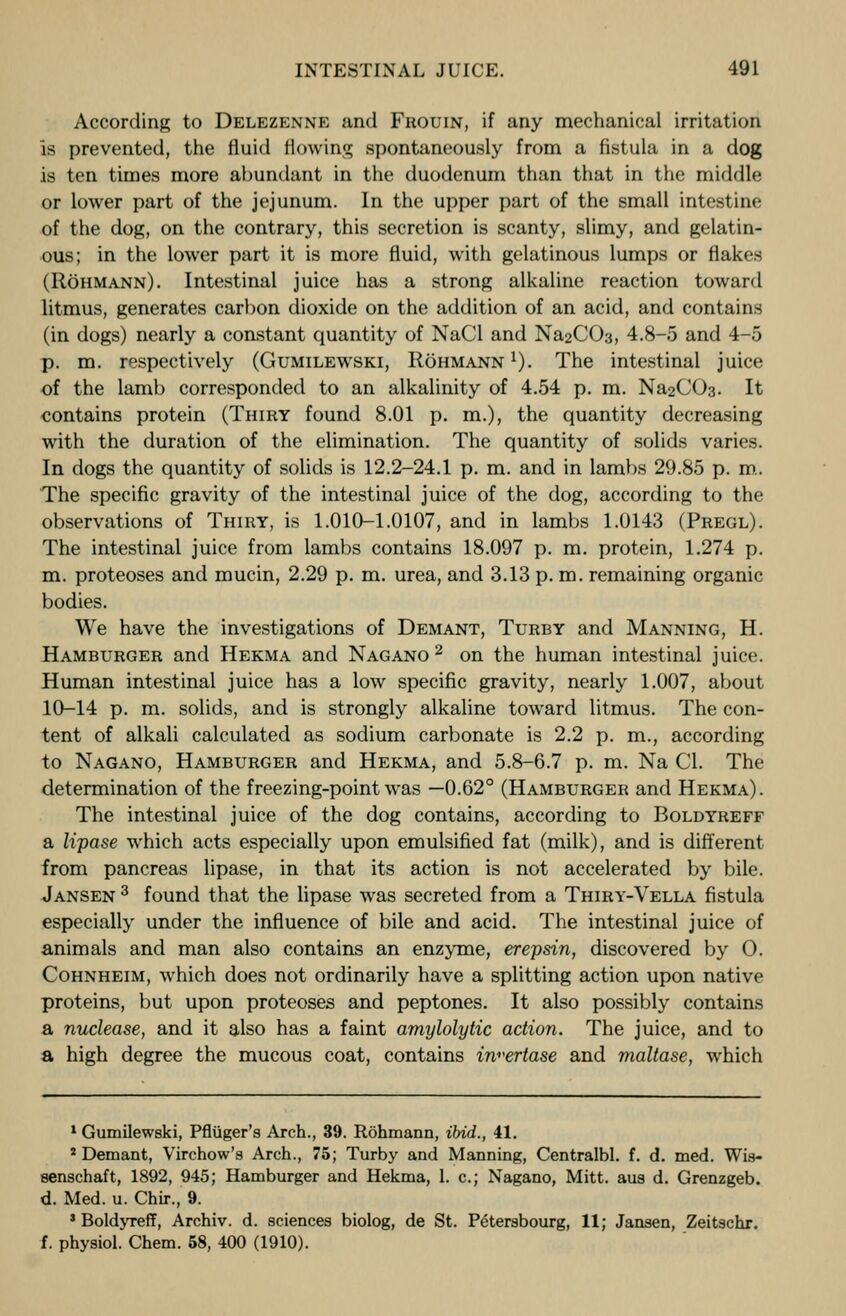
Full resolution (JPEG) - On this page / på denna sida - VIII. Digestion - III. The Glands of the Mucous Membrane of the Intestine and their Secretions

<< prev. page << föreg. sida << >> nästa sida >> next page >>
Below is the raw OCR text
from the above scanned image.
Do you see an error? Proofread the page now!
Här nedan syns maskintolkade texten från faksimilbilden ovan.
Ser du något fel? Korrekturläs sidan nu!
This page has never been proofread. / Denna sida har aldrig korrekturlästs.
INTESTINAL JUICE. 491
According to Delezenne and Frouin, if any mechanical irritation
is prevented, the fluid flowing spontaneously from a fistula in a dog
is ten times more abundant in the duodenum than that in the middle
or lower part of the jejunum. In the upper part of the small intestine
of the dog, on the contrary, this secretion is scanty, slimy, and gelatin-
ous; in the lower part it is more fluid, with gelatinous lumps or flakes
(Rohmann). Intestinal juice has a strong alkaline reaction toward
litmus, generates carbon dioxide on the addition of an acid, and contains
(in dogs) nearly a constant quantity of NaCl and Na2CC>3, 4.8-5 and 4-5
p. m. respectively (Gumilewski, Rohmann 1
). The intestinal juice
of the lamb corresponded to an alkalinity of 4.54 p. m. Na2C03. It
contains protein (Thiry found 8.01 p. m.), the quantity decreasing
with the duration of the elimination. The quantity of solids varies.
In dogs the quantity of solids is 12.2-24.1 p. m. and in lambs 29.85 p. m.
The specific gravity of the intestinal juice of the dog, according to the
observations of Thiry, is 1.010-1.0107, and in lambs 1.0143 (Pregl).
The intestinal juice from lambs contains 18.097 p. m. protein, 1.274 p.
m. proteoses and mucin, 2.29 p. m. urea, and 3.13 p. m. remaining organic
bodies.
We have the investigations of Demant, Turby and Manning, H.
Hamburger and Hekma and Nagano 2
on the human intestinal juice.
Human intestinal juice has a low specific gravity, nearly 1.007, about
10-14 p. m. solids, and is strongly alkaline toward litmus. The con-
tent of alkali calculated as sodium carbonate is 2.2 p. m., according
to Nagano, Hamburger and Hekma, and 5.8-6.7 p. m. Na CI. The
determination of the freezing-point was —0.62° (Hamburger and Hekma).
The intestinal juice of the dog contains, according to Boldyreff
a lipase which acts especially upon emulsified fat (milk), and is different
from pancreas lipase, in that its action is not accelerated by bile.
Jansen 3
found that the lipase was secreted from a Thiry-Vella fistula
especially under the influence of bile and acid. The intestinal juice of
animals and man also contains an enzyme, erepsin, discovered by O.
Cohnheim, which does not ordinarily have a splitting action upon native
proteins, but upon proteoses and peptones. It also possibly contains
a nuclease, and it also has a faint amylolytic action. The juice, and to
a high degree the mucous coat, contains iwertase and maltase, which
1
Gumilewski, Pfliiger’s Arch., 39. Rohmann, ibid., 41.
2
Demant, Virchow’s Arch., 75; Turby and Manning, Centralbl. f. d. med. Wis-
senschaft, 1892, 945; Hamburger and Hekma, 1. c; Nagano, Mitt, aus d. Grenzgeb.
d. Med. u. Chir., 9.
1
Boldyreff, Archiv. d. sciences biolog, de St. P6tersbourg, 11; Jansen, Zeitschr.
f. physiol. Chem. 58, 400 (1910).
<< prev. page << föreg. sida << >> nästa sida >> next page >>